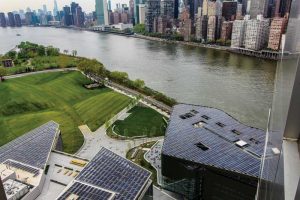As solar energy becomes increasingly mainstream, thoughtful consideration of how best to integrate this photovoltaic (PV) technology into new construction has long-term implications for project success and building owner and occupant satisfaction. Architects, builders, and specifiers have a critical role to play in ensuring new structures incorporate quality PV products. Owners and builders’ priorities as they undergo the process of evaluating solar products for deployment in new structures must be the selection of efficient, affordable, and attractive PV technology.
Construction professionals, property owners, and communities are increasingly interested in lowering their carbon footprint, and building high-performance, net zero-energy structures. For years, builders and architects have visualized the construction of self-sustaining buildings that generate their own power. Today, the concept of a solar-powered building is neither remote nor unachievable. Thanks to recent advancements, architects, engineers, developers, and builders can deploy solar everywhere—on rooftops, building façades, and even in windows. The dream of having buildings performing as their own clean power plants and generating their own clean energy is being realized. For example, a 900-kW PV array deployed atop two buildings at Cornell Tech in New York City advance the institutional goal of achieving a net zero-energy campus by delivering outstanding performance, affordability, attractive aesthetics, and high efficiency and energy yield. A new 1.72-MW solar system deployed at an IKEA outlet near San Antonio, Texas, produces 2.5 million kWh of electricity annually for the store, the equivalent of providing electricity for 280 homes (~ to reducing 1868 tons of carbon dioxide [CO2] and equal to eliminating emissions from 400 cars).
Increased PV deployment is being driven by customer demand, the desire to reduce impacts of CO2 emissions, and attractive economics. Solar deployment has been growing rapidly in the United States, with zero prospect of tapering off.
Six years ago, the United States had less than 1 GW of deployed solar generation. Today, it has cumulatively more than 64 GW of deployed solar, and there is 108 GW of PV capacity worldwide.

New standards and incentives are helping boost solar deployment in the United States. Last year, California instituted a new building code requiring all new homes constructed after January 1, 2020, to be outfitted with solar. Cities in Arizona, Florida, and Massachusetts have established similar requirements. Watertown in Massachusetts requires solar deployment on all new commercial buildings larger than 929 m2 (10,000 sf) and all new residential structures of 10 or more units. Other states and municipalities will likely follow suit, rolling out similar policies in the years to come, as jurisdictions make increasingly ambitious commitments to renewable energy adoption.
New residential and commercial construction with solar is increasing. Solar suppliers and electrical contractors are supporting the integration of PV into new design/build. Every major electrical supply house in the nation is providing a complete line of electrical management systems to support solar energy integration. Residential, commercial, and utility-grid interconnect of solar generators is widely permitted.
The process of utility-grid connection works as follows: solar installation companies typically submit interconnect applications on behalf of the utility account holder. To process the permit, the system owner’s utility requires information about a property’s electricity usage and system specifics (e.g. size, equipment, design, generation estimates, and location). Once the utility grants approval, the PV system installation may proceed. Upon completion, both the local government and the customer’s utility company send representatives to examine the system—inspect the inverter, connection at the electrical panel, and functionality. The utility then installs/upgrades a more sophisticated meter that tracks solar electricity exports to the grid, enabling the system owner to leverage the utility’s net-metering incentive. Following inspection and meter upgrade, the final step in interconnection is the granting of permission to operate (PTO). Official PTO documentation notifies the owner they can officially turn on the solar panel system for electricity generation. Utility-scale installation can be more complex, and frequently require transmission upgrades to the local distribution system. These costs are usually borne by the solar project developer.
Solar energy is fully embedded in Article 690 of the National Electrical Code (NEC) that provides definitions and guidelines for solar PV electrical energy systems, array circuit(s), inverter(s), and charge controller(s) for design, deployment, and permitting.
Almost all of the solar PV technology deployed today is in the form of rooftop panels installed in essentially the same manner as those retrofitted to existing structures. Mounts/racking are installed on existing roofs, solar panels are fixed to the racks, and the remaining components (inverter, wiring, interconnections) are incorporated to complete the solar energy system.
When the roof is invisible because of parapets, height, or other factors, this tried-and-true method of deployment makes both environmental and economic sense. However, when the PV system being deployed is more visible, building architects and owners are demanding alternatives that add, rather than detract, from the aesthetic look of the new building.
These alternatives start with deploying more attractive and efficient solar panels. PV panel grid lines, busbars, and the circuitry—historically associated with conventional solar panels—result in visually calling undue attention to internal electrical components. That distinctive conventional solar panel ‘look’ is inconsistent with the aesthetic aims associated with many modern buildings’ materials, surfaces, and specifications.
More efficient panels—devoting almost all of their surface area to generating electricity—are now available on the market. Advances in PV panel manufacturing have transformed solar cells from discrete components into aesthetic monolithic structures without inactive unattractive spacing (e.g. busbars) between cells. Not only do these advances make solar panels more efficient by increasing their energy yield, but also present a more attractive and consistent appearance pleasing to the eye. For example, some solar panels on the market offer a uniform look without visible busbars, circuitry, or gridlines.
In many instances, when designing and developing new structures, specifying all-black panels and thoughtfully integrating proven mounting techniques enables builders to meet and exceed requirements for attractive aesthetics and higher efficiency. High-efficiency solar panels are suitable for space-constrained applications in residential and commercial construction. A key benefit of deploying high-efficiency solar panels is that this cost-competitive approach empowers builders to successfully achieve both their environmental and economic goals.





